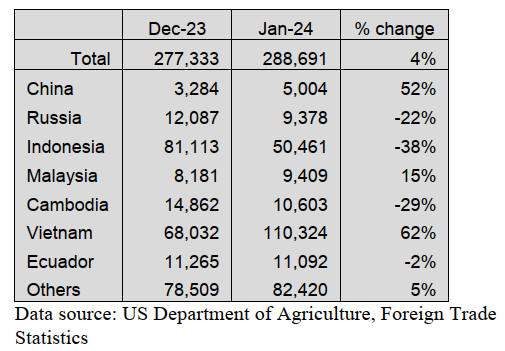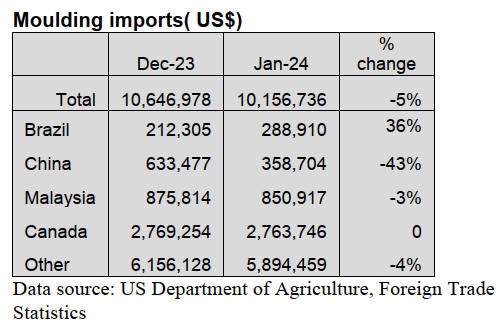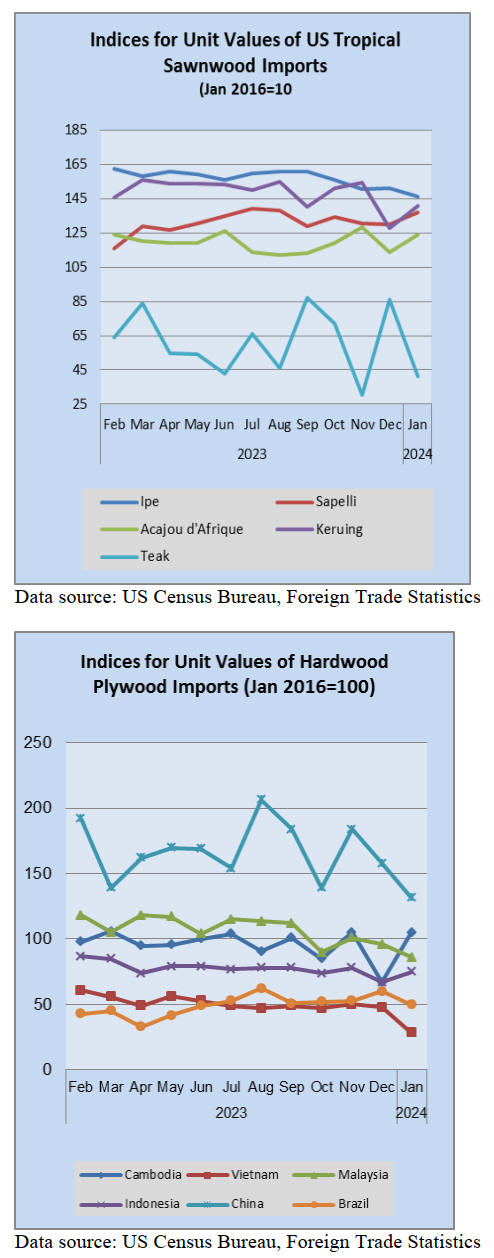|
Report from
North America
Hardwood plywood imports nearly doubled
US imports of hardwood plywood in January nearly
doubled that of the previous January as the country
imported 288,691 cubic metres. While the total is only a
4% rise from December and is 27% less than the January
2022 haul, the 95% gain over last January is a very
positive sign that imports are continuing to recover from
last year’s slump.

Imports from Vietnam rose 62% in January to their highest
volume since April 2022. Strong gains were made in
imports from China (up 52%) and Malaysia (up 15%)
while imports from Indonesia and Cambodia showed
higher volume than a year ago despite dropping from
December totals.
Sawn tropical hardwood imports continue to rebound
US imports of sawn tropical hardwood rose 22% in
January, climbing for the second straight month after
hitting a two-year low in November. Despite the rise the
16,228 cubic metres imported in January was 7% less than
the previous January’s total. Imports from Brazil rose 76%
and imports from Malaysia rose 25%, yet both still fell
short of their January 2023 levels.
Imports of Balsa and Virola started 2024 strong as January
levels of each were more than quadruple that of the
previous January. Imports of paduak, teak, and jatoba in
January were less than half of their January 2023 totals.
Imports of sapelli rose 31% in January but were down 4%
from a year ago.

Canadian imports of sawn tropical hardwood retreated
26% in January after reaching their highest level in nearly
10 years in December. Even with the decline, the January
total of just under US$2 million was 54% higher than
January of 2023. Imports from Cameroon accounted for
more than US$1.1 million, which is the highest level of
any country for one month in at least 10 years.
US veneer imports edge down
US imports of tropical hardwood veneer fell 7% in
January. Despite the drop, at US$2.9 million imports were
3% higher than in January 2023. This occurred despite the
fact that imports from Italy, which continue to be highly
volatile from month to month, fell by 93% from the
previous month and were 94% off last January’s level.
Imports from Cameroon continued to grow in January,
gaining 3% for the month to a level more than four times
that of January 2023. Imports from Cote d’Ivoire were
also strong, gaining 136% over the previous month to
roughly double that of last January. Imports from China
rebounded from an anemic December figure but were still
down 23% from January 2023 levels.
Hardwood flooring imports fell more than 10% in
January
Imports of hardwood flooring by the US fell 11% in
January on sharp declines from the top suppliers. Imports
from Indonesia fell 46% in January while imports from
Brazil dropped by 23%. Compared to January 2023
figures, imports from both countries were down by about
60%.
Imports from Malaysia, which hit a 2-year low in
December, grew 80% in January but were still 43% less
than that of the previous January. Total imports in January
were down 23% from January 2023 figures.
US Imports of assembled flooring panels also fell in
January, declining 14% from the previous month. Imports
from Thailand fell 30% in January while imports from
Vietnam and Brazil each saw a 28% drop.
Despite the decline, imports from all three countries were
well above their January 2023 levels. Imports from
Canada started 2024 strong with January figures up 7%
from the previous month and 41% above their level from a
year ago. Total imports of assembled flooring panels for
January were 29% higher than in January 2023.
Moulding imports slip
US imports of hardwood mouldings dropped 5% in
January as imports from China declined by nearly half.
Imports from China fell 43% in January to less than half of
what they were in January 2023. Imports from Brazil were
also far behind last January’s levels, trailing 66% from a
year ago despite gaining 36% from the previous month.

Imports from Canada remained level for the month.
Imports of hardwood moulding in January 2024 were
down 7% from the previous January.
US wooden furniture imports held steady in January
US imports of wooden furniture were flat in January,
rising less than 1% from December totals. At US$1.73
billion, imports for the month were 4% below that of
January 2023. However, January 2023 was
uncharacteristically that year’s strongest month for
imports, so any gains in the near future should propel 2024
ahead of last year’s numbers. Imports from China and
Indonesia both rose 10% in January, while imports from
India fell 19% and imports from Vietnam fell 5%.
US cabinet and vanity sales fell in 2023
Sales of kitchen cabinets and bathroom vanities, impacted
by slowdowns in both the new construction and residential
remodeling sectors, declined last year from their 2022
totals the Kitchen Cabinet Manufacturers
Association(KCMA) reported.
The KCMA reported that overall cabinet and vanity sales
for the year were down 2.3% compared to 2022, falling
from a total of US$2.866 billion to US$2.801 billion. The
decline was fueled entirely by a shortfall in sales of stock
cabinets which were down 19.4% from the prior year.
By comparison, sales gains were posted for both custom
(+5.0%) and semi-custom cabinets (0.5%) the KCMA
reported. KCMA also reported that January 2024 sales
continued the downward trend with overall sales down 7%
versus January 2023 as custom sales lagged by more
18.2%.
See:
https://kcma.org/insights/january-trend-business-report-0
Construction firms report mixed outlook for 2024
Construction contractors have a decidedly mixed outlook
for 2024 as firms predict transitions in demand for
projects, the types of challenges they will face and the
technologies (including artificial intelligence) they will
embrace according to survey results by Sage and the
Associated General Contractors of America. Amid these
changes contractors are struggling to cope with significant
labour shortages, the impacts of higher interest rates and
input costs and a supply chain that, while better, is still far
from normal.
“2024 offers a mixed bag for construction contractors; on
one hand, demand for many types of projects should
continue to expand and firms will continue to invest in the
tools they need to be more efficient,” said Stephen E.
Sandherr, the Association’s Chief Executive Officer.
“Meanwhile, they face significant challenges when it
comes to finding workers, coping with rising costs and
weathering the impacts of higher interest rates.”
See:
https://www.agc.org/sites/default/files/users/user21902/2024%20Construction%20Hiring%20and%20Business%20Outlook%20Report_V2.pdf

|